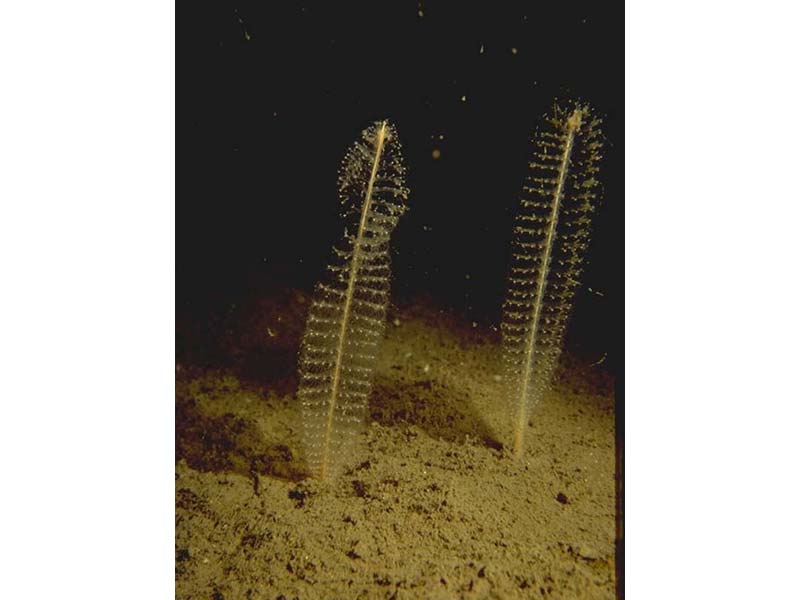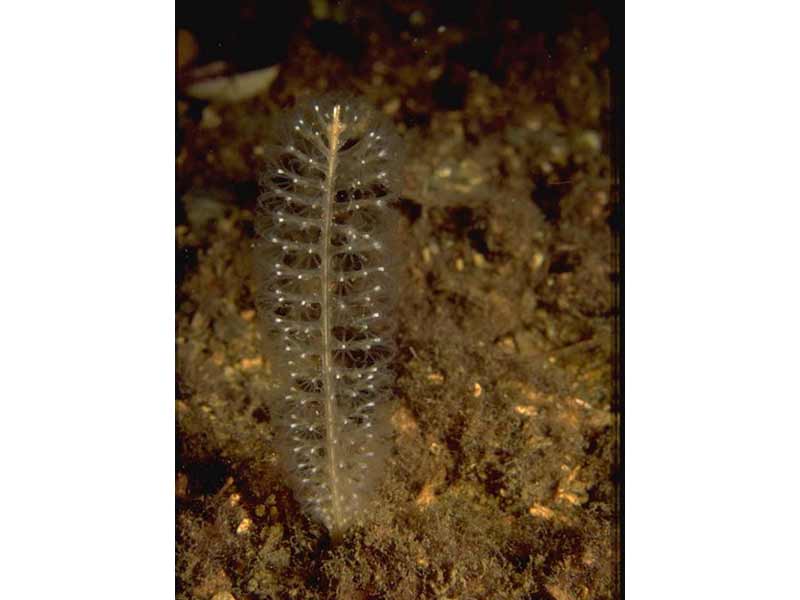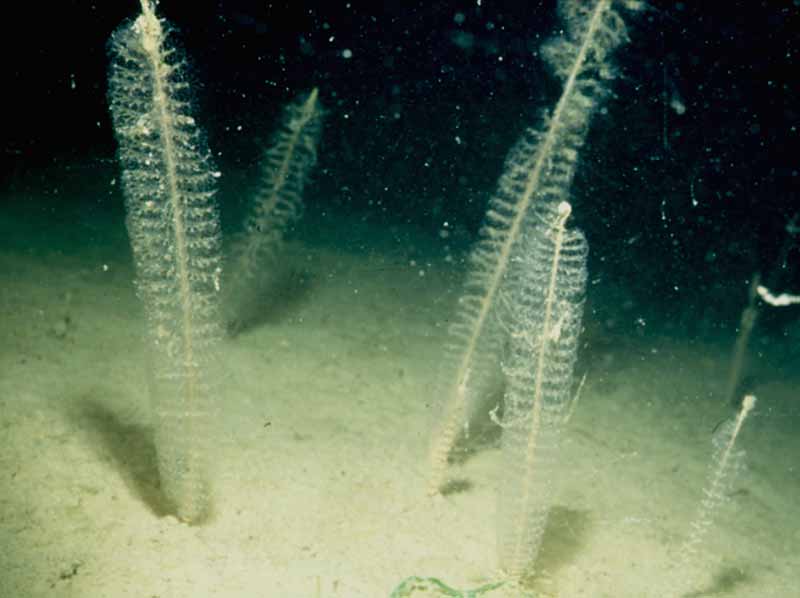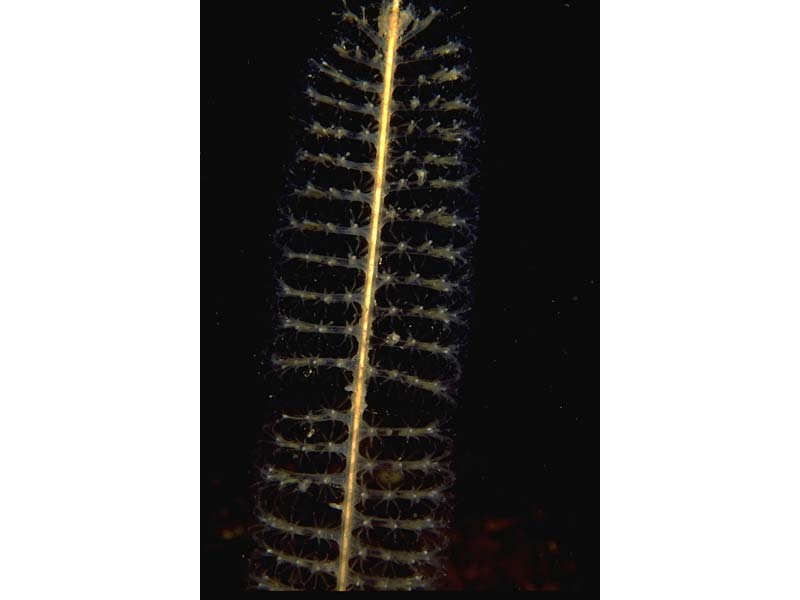Slender sea pen (Virgularia mirabilis)
Distribution data supplied by the Ocean Biodiversity Information System (OBIS). To interrogate UK data visit the NBN Atlas.Map Help
| Researched by | Emily Wilson & Jacqueline Hill | Refereed by | This information is not refereed |
| Authority | (Müller, 1776) | ||
| Other common names | - | Synonyms | - |
Summary
Description
A slender sea pen up to 60 cm long with a central stem only a few millimetres thick. Retractile tentacled polyps are fused into small 'leaves' which are arranged in two opposing lateral rows on the central stem. The colony varies in colour from white to creamy yellow in colour. May luminesce in darkness.
Recorded distribution in Britain and Ireland
Found of all British and Irish coasts but less frequent in the south.Global distribution
Western Europe and Mediterranean, occurs throughout the North Atlantic possibly as far as North America.Habitat
Virgularia mirabilis lives in fine sediments (muddy sand to soft mud). The species is found in sheltered inshore waters, or in deeper water offshore, from 12 - 400 m depth. The species is often very abundant in sea lochs or man-made harbours.Depth range
10-400mIdentifying features
See additional information for explanation of terms.
- Very slender sea-pen, up to 60 cm long with the axial polyp 2-4 mm in diameter.
- Axis round in cross-section.
- Stalk about equal in length to the rachis, or a little shorter.
- Up to 12 autozooids on each leaf; they are long when expanded and very retractile due to the absence of sclerites.
- Sclerites (skeletal element) are totally absent.
- Non-retractile siphonozooids are located in a single oblique row a the foot of each leaf but are small and inconspicuous.
- Colouration of the colony from white to creamy yellow.
Additional information
As is the case for all octocorals, sea pens are actually colonies of polyps. What distinguishes sea pens is polyp dimorphism. One polyp grows very large and loses its tentacles, forming the central axis. The central axial polyp is divided into two regions: a lower peduncle or stalk, which never bears secondary polyps and functions as a burrowing organ, and an upper stem or rachis, from which numerous secondary polyps bud. Some of these secondary polyps, called autozooids, are typical feeding polyps. Others, the larger and fewer siphonozooids, serve as intakes for water, which circulates within the colony and helps keep it upright. The axial polyp contains a slender, unbranched, calcareous skeletal rod (axis). In this species, the axis is round in section and often protrudes from the top of the colony. Virgularia mirabilis lives upright with their stalks thrust into a mucus-lined burrow into which the whole colony can withdraw when disturbed.
Listed by
Biology review
Taxonomy
| Level | Scientific name | Common name |
|---|---|---|
| Phylum | Cnidaria | Sea anemones, corals, sea firs & jellyfish |
| Class | Anthozoa | Sea anemones, soft & cup corals, sea pens & sea pansies |
| Order | Scleralcyonacea | |
| Family | Virgulariidae | |
| Genus | Virgularia | |
| Authority | (Müller, 1776) | |
| Recent Synonyms | ||
Biology
| Parameter | Data | ||
|---|---|---|---|
| Typical abundance | |||
| Male size range | <60 cm | ||
| Male size at maturity | |||
| Female size range | Large(>50cm) | ||
| Female size at maturity | |||
| Growth form | Pinnate | ||
| Growth rate | |||
| Body flexibility | Low (10-45 degrees) | ||
| Mobility | Sessile, permanent attachment | ||
| Characteristic feeding method | Passive suspension feeder | ||
| Diet/food source | Planktotroph | ||
| Typically feeds on | Plankton and organic particles. | ||
| Sociability | Solitary | ||
| Environmental position | Epifaunal | ||
| Dependency | Independent. | ||
| Supports | Substratum the nudibranch Armina loveni. | ||
| Is the species harmful? | No | ||
Biology information
Typical abundance: usually found at densities of ca >5 individuals / m2.
Flexibility. Eno et al. (1996) found that sea pens bent away from lobster pots dropping on top of them in a passive response to the pressure wave travelling ahead of the dropping pot.
Feeding. Virgularia mirabilis does possess nematocysts and so the species is probably capable of both passive predation on small zooplanktonic organisms and suspension feeding of suspended material (Hoare & Wilson, 1977). Laboratory experiments have shown that the polyps of Virgularia mirabilis are capable of capturing (by trapping with nematocysts) and ingesting small active organisms such as Artemia nauplii. However, Virgularia mirabilis is a passive carnivore, waiting for small animals that stumble, or are swept, into the tentacles of the sea pen. Suspension feeding occurs when very small particles become trapped in mucus on the tentacles and are then transported to the mouth by cilia. Suspension feeding is evidenced by the orientation of many colonies at right angles to the water current.
Predation. Evidence of predation on Virgularia mirabilis seems limited to a report by Marshall & Marshall (1882 cited in Hoare & Wilson, 1977) that the species was found in the stomach of haddock. However, observations by Hoare & Wilson (1977) suggested that predation pressure on this species was low.
Habitat preferences
| Parameter | Data |
|---|---|
| Physiographic preferences | Offshore seabed, Sea loch or Sea lough, Enclosed coast or Embayment |
| Biological zone preferences | Circalittoral offshore, Lower circalittoral, Lower infralittoral, Upper circalittoral |
| Substratum / habitat preferences | Coarse clean sand, Fine clean sand, Mud, Muddy sand, Sandy mud |
| Tidal strength preferences | Very weak (negligible), Weak < 1 knot (<0.5 m/sec.) |
| Wave exposure preferences | Extremely sheltered, Sheltered, Ultra sheltered, Very sheltered |
| Salinity preferences | Full (30-40 psu) |
| Depth range | 10-400m |
| Other preferences | No text entered |
| Migration Pattern | Non-migratory or resident |
Habitat Information
No text enteredLife history
Adult characteristics
| Parameter | Data |
|---|---|
| Reproductive type | Gonochoristic (dioecious) |
| Reproductive frequency | Annual episodic |
| Fecundity (number of eggs) | No information |
| Generation time | Insufficient information |
| Age at maturity | Insufficient information |
| Season | June - October |
| Life span | See additional information |
Larval characteristics
| Parameter | Data |
|---|---|
| Larval/propagule type | - |
| Larval/juvenile development | Lecithotrophic |
| Duration of larval stage | See additional information |
| Larval dispersal potential | Greater than 10 km |
| Larval settlement period | Insufficinet information |
Life history information
- The sexes are separate in sea pens. Each colony of polyps is either male or female.
- There is very little information on population structure or life cycles in any of the British sea pens, but the limited data available from other species would lead one to predict a similar pattern of patchy recruitment, slow growth and long lifespan (Hughes, 1998(b)).
- In other species of sea pen the eggs and sperm are released from the polyps and fertilization takes place externally. The sea pen Ptilosarcus guerneyi spawns in late March, with up to 200,000 eggs produced per female colony. Chia & Crawford, (1973) found free-swimming larvae of this species did not feed, suggesting a lecithotrophic larvae, and settled within seven days if a suitable substratum was encountered. Birkeland, (1974) found the lifespan of Ptilosarcus guerneyi to be up to 15 years, taking 5 or 6 years to reach sexual maturity.
Sensitivity review
The MarLIN sensitivity assessment approach used below has been superseded by the MarESA (Marine Evidence-based Sensitivity Assessment) approach (see menu). The MarLIN approach was used for assessments from 1999-2010. The MarESA approach reflects the recent conservation imperatives and terminology and is used for sensitivity assessments from 2014 onwards.
Physical pressures
Use / to open/close text displayed
| Intolerance | Recoverability | Sensitivity | Evidence / Confidence | |
Substratum loss [Show more]Substratum lossBenchmark. All of the substratum occupied by the species or biotope under consideration is removed. A single event is assumed for sensitivity assessment. Once the activity or event has stopped (or between regular events) suitable substratum remains or is deposited. Species or community recovery assumes that the substratum within the habitat preferences of the original species or community is present. Further details EvidenceThe species lives in the substratum so substratum loss will mean loss of the population. There is very little information on population structure or life cycles in any of the British sea pens, but the limited data available from other species would lead one to predict a similar pattern of patchy recruitment, slow growth and long life-span (Hughes, 1998(b)). Larval settlement is likely to be patchy in space and highly episodic in time with no recruitment to the population taking place for some years. In Holyhead harbour, for example, animals show a patchy distribution, probably related to larval settlement (Hoare & Wilson, 1977). Therefore, provided that a suitable substratum remains, recoverability is expected to be moderate. | High | Moderate | Moderate | Moderate |
Smothering [Show more]SmotheringBenchmark. All of the population of a species or an area of a biotope is smothered by sediment to a depth of 5 cm above the substratum for one month. Impermeable materials, such as concrete, oil, or tar, are likely to have a greater effect. Further details. EvidenceIndividual colonies extend up to 30cm above the sediment so are unlikely to be significantly affected by smothering by 5cm of sediment. There may be an increase in the energetic cost of cleaning sediment from the polyps. Eno et al., (1996) found that another species of sea pen, Funiculina quadrangularis when partially buried still showed signs of polyp activity on parts of the sea pen that were visible. In an investigation into the effect of shellfish traps on benthic habitats (Eno et al., 1996) creels were dropped on sea pens and left for extended periods to simulate the effects of smothering which could occur during commercial operations. The sea pens consistently righted themselves following removal of the pots indicating recovery is likely to be immediate. | Low | Immediate | Not sensitive | Moderate |
Increase in suspended sediment [Show more]Increase in suspended sedimentBenchmark. An arbitrary short-term, acute change in background suspended sediment concentration e.g., a change of 100 mg/l for one month. The resultant light attenuation effects are addressed under turbidity, and the effects of rapid settling out of suspended sediment are addressed under smothering. Further details EvidenceThe effect of increased deposition of fine silt is uncertain but it is possible that feeding structures may become clogged. When tested Virgularia mirabilis quickly seized and rejected inert particles (Hoare & Wilson, 1977). Hiscock (1983) observed Virgularia mirabilis secretes copious amounts of mucus and, as a species living in a very sheltered area subject to high suspended sediment loads, the mucus could clearly keep the polyps clear of silt. Hoare & Wilson (1977) also suggested there is a tendency for animals to withdraw into the sediment when there was a high level of tidally-suspended sediment in the water. There was however, much variation. Eno et al., (1996) found that another species of sea pen, Funiculina quadrangularis, was quick to remove any adhering mud particles by the production of copious quantities of mucus. Virgularia mirabilis is also likely to be able to self-clean. However, if feeding is reduced by increases in siltation the viability of the population will be reduced. Once siltation levels return to normal, feeding will be resumed therefore recoverability will be immediate. | Low | Immediate | Not sensitive | Moderate |
Decrease in suspended sediment [Show more]Decrease in suspended sedimentBenchmark. An arbitrary short-term, acute change in background suspended sediment concentration e.g., a change of 100 mg/l for one month. The resultant light attenuation effects are addressed under turbidity, and the effects of rapid settling out of suspended sediment are addressed under smothering. Further details Evidence | No information | |||
Desiccation [Show more]Desiccation
EvidenceVirgularia mirabilis is a sub-tidal species that is likely to be highly intolerant of desiccation. Exposure to air for a period of an hour would probably result in the death of individuals. However, the species only occurs in the circalittoral zone (below 10 m) where desiccation is not a factor so intolerance has been assessed as not relevant. | Not relevant | Not relevant | Not relevant | High |
Increase in emergence regime [Show more]Increase in emergence regimeBenchmark. A one hour change in the time covered or not covered by the sea for a period of one year. Further details EvidenceVirgularia mirabilis is a sub-tidal species that is likely to be highly intolerant of emergence. Emersion from seawater for a period of an hour, where the species would be subject to conditions such as desiccation and temperature changes, would probably result in the death of individuals. However, the species only occurs in the circalittoral zone (below 10 m) where emergence does not occur so intolerance has been assessed as not relevant. | Not relevant | Not relevant | Not relevant | High |
Decrease in emergence regime [Show more]Decrease in emergence regimeBenchmark. A one hour change in the time covered or not covered by the sea for a period of one year. Further details Evidence | No information | |||
Increase in water flow rate [Show more]Increase in water flow rateA change of two categories in water flow rate (view glossary) for 1 year, for example, from moderately strong (1-3 knots) to very weak (negligible). Further details EvidenceVirgularia mirabilis is found in habitats associated with physically-sheltered conditions of weak and very weak water flow rates, therefore intolerance to water flow rate is likely to be high. As water flow rates increase, Virgularia mirabilis first responds by swinging polyps around the axial rod to face away from the current, then polyps face downstream. With further increases the stalk bends over and the pinnae are pushed together to an increasing amount with increasing velocity of flow. Finally, tentacles retract and at water speeds greater than 0.5m/s (i.e. 1 knot) the stalk retracts into the mud (Hiscock, 1983). If water speeds remain at this level or above the sea-pen will be unable to extend above the sediment, unable to feed and will die. Therefore, intolerance to an increase in water flow, at the benchmark level is high. There is very little information on population structure or life cycles in any of the British sea pens, but the limited data available from other species would lead one to predict a similar pattern of patchy recruitment, slow growth and long life-span (Hughes, 1998(b)). Larval settlement is likely to be patchy in space and highly episodic in time with no recruitment to the population taking place for some years. Therefore, provided that a suitable substratum remains, recoverability is expected to be moderate. | High | Moderate | Moderate | High |
Decrease in water flow rate [Show more]Decrease in water flow rateA change of two categories in water flow rate (view glossary) for 1 year, for example, from moderately strong (1-3 knots) to very weak (negligible). Further details Evidence | No information | |||
Increase in temperature [Show more]Increase in temperature
For intertidal species or communities, the range of temperatures includes the air temperature regime for that species or community. Further details EvidenceNo information was found on the upper or lower limits of Virgularia mirabilis tolerance to temperature changes. The species occurs from North America to the Mediterranean and so may be able to tolerate long term changes in temperature. However, the species is subtidal where wide variations in temperature, such as experienced in the intertidal, are not so common and so may be more intolerant of short term changes. Intolerance has therefore, been assessed as intermediate. | Intermediate | Moderate | Moderate | Low |
Decrease in temperature [Show more]Decrease in temperature
For intertidal species or communities, the range of temperatures includes the air temperature regime for that species or community. Further details Evidence | No information | |||
Increase in turbidity [Show more]Increase in turbidity
EvidenceVirgularia mirabilis is insensitive to light (Hoare & Wilson, 1977) therefore an increase or decrease in light levels caused by changing turbidity levels will have little or no effect on the sea pen population. | Tolerant | Not relevant | Not sensitive | Not relevant |
Decrease in turbidity [Show more]Decrease in turbidity
Evidence | No information | |||
Increase in wave exposure [Show more]Increase in wave exposureA change of two ranks on the wave exposure scale (view glossary) e.g., from Exposed to Extremely exposed for a period of one year. Further details EvidenceVirgularia mirabilis is found in habitats with low wave exposure. In Holyhead Harbour Hoare & Wilson (1977) found that, with increasing distance from the breakwater of the harbour, where wave exposure increases, individuals became smaller and less common. An increase of two scales in the exposure scale is likely to kill Virgularia mirabilis populations so intolerance is high. However, only those populations in relatively shallow water are likely to be affected by the factor. Recruitment is probably sporadic and so recovery is assessed as moderate. | High | High | Moderate | Moderate |
Decrease in wave exposure [Show more]Decrease in wave exposureA change of two ranks on the wave exposure scale (view glossary) e.g., from Exposed to Extremely exposed for a period of one year. Further details Evidence | No information | |||
Noise [Show more]Noise
EvidenceVirgularia mirabilis can withdraw into its burrow when disturbed. The species is likely to be sensitive to vibrations in the surrounding water rather than noise itself. The presence of noise, at the benchmark level such as the regular passing of a 30 metre trawler at 100 metres, effects are likely to be minimal and if disturbed the sea-pen would re-emerge as soon as conditions return to normal. Thus, recovery would be immediate. | Low | Immediate | Not sensitive | Low |
Visual presence [Show more]Visual presenceBenchmark. The continuous presence for one month of moving objects not naturally found in the marine environment (e.g., boats, machinery, and humans) within the visual envelope of the species or community under consideration. Further details EvidenceVirgularia mirabilis has very limited, if any, ability for visual perception. The sea pen is unlikely to be sensitive to visual presence. | Tolerant | Not relevant | Not sensitive | High |
Abrasion & physical disturbance [Show more]Abrasion & physical disturbanceBenchmark. Force equivalent to a standard scallop dredge landing on or being dragged across the organism. A single event is assumed for assessment. This factor includes mechanical interference, crushing, physical blows against, or rubbing and erosion of the organism or habitat of interest. Where trampling is relevant, the evidence and trampling intensity will be reported in the rationale. Further details. EvidenceSea pens retract slowly and are likely to be intolerant of abrasion by trawling for instance, which is likely to break the rachis of Virgularia mirabilis. Species obtained by dredges were invariably damaged (Hoare & Wilson, 1977). However, the densities of Virgularia mirabilis were similar in trawled and untrawled sites in Loch Fyne and no changes in sea pen density was observed after experimental trawling over a 18 month period in another loch (Howson & Davies, 1991; Tuck et al., 1998; Hughes, 1998b). Hughes (1998b) concluded that Virgularia mirabilis and Pennatula phosphorea, which can withdrawn into the sediment, were probably less susceptible to the effects of damage by fishing gear than Funiculina quadrangularis, which is unable to withdraw. In an investigation into the effect of shellfish traps on benthic habitats (Eno et al., 1996), creels were dropped on sea pens and left for extended periods to simulate the effects of smothering which could occur during commercial operations. Sea pens were seen to bend away in response to the pressure wave travelling ahead of the dropping pot. The sea pens consistently righted themselves following removal of the pots.Eno et al. (1996) found that even if damaged, another species of sea pen, Funiculina quadrangularis, appeared to remain functional and this could also be true of Virgularia mirabilis. However, the long term effects are unknown. Overall, a proportion of the population may be damaged and die. Hence, an intolerance of intermediate has been recorded. Recoverability is likely to be moderate. | Intermediate | Moderate | Moderate | Moderate |
Displacement [Show more]DisplacementBenchmark. Removal of the organism from the substratum and displacement from its original position onto a suitable substratum. A single event is assumed for assessment. Further details EvidenceDisplaced individuals, which are not damaged (see Abrasion above for damage), will re-burrow (Jones et al., 2000) and recover completely within 72 hours, provided the basal peduncle remains in contact with the sediment surface. Eno et al., (1996) found that even when damaged another species of sea pen, Funiculina quadrangularis, appeared to remain functional. This could also be true of Virgularia mirabilis. During a manipulative experiment to examine the effect of extensive and repeated experimental trawl disturbance over an 18 month period Tuck et al. (1998) reported no effects on the abundance and distribution of Virgularia mirabilis. The authors suggest the reason for this may be the species ability to rapidly withdraw into the sediment, thereby avoiding damage. | Low | Immediate | Not sensitive | Moderate |
Chemical pressures
Use [show more] / [show less] to open/close text displayed
| Intolerance | Recoverability | Sensitivity | Evidence / Confidence | |
Synthetic compound contamination [Show more]Synthetic compound contaminationSensitivity is assessed against the available evidence for the effects of contaminants on the species (or closely related species at low confidence) or community of interest. For example:
The evidence used is stated in the rationale. Where the assessment can be based on a known activity then this is stated. The tolerance to contaminants of species of interest will be included in the rationale when available; together with relevant supporting material. Further details. EvidenceInsufficientinformation. | No information | No information | No information | Not relevant |
Heavy metal contamination [Show more]Heavy metal contaminationEvidenceInsufficientinformation. | No information | No information | No information | Not relevant |
Hydrocarbon contamination [Show more]Hydrocarbon contaminationEvidenceInsufficientinformation. | No information | No information | No information | Not relevant |
Radionuclide contamination [Show more]Radionuclide contaminationEvidenceVirgularia mirabilis occurred in high density (10/m²) at a sampling station immediately offshore from the Sellafield outfall pipeline in the Irish Sea (Hughes & Atkinson, 1997). Bottom sediments in this area contains particles of long half life radionuclides from the liquid effluent and so intolerance is assessed as low. | Low | High | Low | Low |
Changes in nutrient levels [Show more]Changes in nutrient levelsEvidenceHoare & Wilson (1977) noted that Virgularia mirabilis was absent from part of the Holyhead Harbour heavily affected by sewage pollution. However, the species was abundant near the head of Loch Harport, Skye, close to a distillery outfall discharging water enriched in malt and yeast residues and other soluble organic compounds (Nickell & Anderson, 1977 in Hughes, 1998). The organic content of the sediment was up to 5%. Virgularia mirabilis was also present in Loch Sween in Scotland where organic content is also as high as 5%. Thus it seems likely that sea pen communities are able to tolerate some nutrient enrichment and so intolerance is assessed as low. | Low | High | Low | Moderate |
Increase in salinity [Show more]Increase in salinity
EvidenceJones et al. (2000) suggest that Virgularia mirabilis appears to be somewhat tolerant of occasional lowering of salinity. However, the species is found only in fully marine conditions and so is likely to be intolerant of a long term, chronic change; e.g., a change of one category from the MNCR salinity scale for one year and so intolerance is assessed as high. Recovery is assessed as moderate because of the sporadic nature of recruitment. | High | Moderate | Moderate | Low |
Decrease in salinity [Show more]Decrease in salinity
Evidence | No information | |||
Changes in oxygenation [Show more]Changes in oxygenationBenchmark. Exposure to a dissolved oxygen concentration of 2 mg/l for one week. Further details. EvidenceStratification of the water column and hypoxia in near-bottom water is especially likely to occur during warm temperatures in semi-enclosed water bodies such as sea lochs. Virgularia mirabilis is often found in sea lochs so may be able to tolerate some reduction in oxygenation. However, Jones et al., (2000) found sea pen communities to be absent from areas which are deoxygenated and characterised by a distinctive bacterial community and Hoare & Wilson (1977) reported Virgularia mirabilis absent from sewage related anoxic areas of Holyhead harbour. Intolerance is therefore, assessed as high. There is very little information on population structure or life cycles in any of the British sea pens, but the limited data available from other species would lead one to predict a similar pattern of patchy recruitment, slow growth and long life-span (Hughes, 1998(b)). Larval settlement is likely to be patchy in space and highly episodic in time with no recruitment to the population taking place for some years. | High | Moderate | Moderate | Low |
Biological pressures
Use [show more] / [show less] to open/close text displayed
| Intolerance | Recoverability | Sensitivity | Evidence / Confidence | |
Introduction of microbial pathogens/parasites [Show more]Introduction of microbial pathogens/parasitesBenchmark. Sensitivity can only be assessed relative to a known, named disease, likely to cause partial loss of a species population or community. Further details. EvidenceNo information on diseases of Virgularia mirabilis was found. | No information | No information | No information | Not relevant |
Introduction of non-native species [Show more]Introduction of non-native speciesSensitivity assessed against the likely effect of the introduction of alien or non-native species in Britain or Ireland. Further details. EvidenceThere are no non-native species of sea-pens that compete with Virgularia mirabilis (Eno et al., 1997). | Tolerant | Not relevant | Not sensitive | Moderate |
Extraction of this species [Show more]Extraction of this speciesBenchmark. Extraction removes 50% of the species or community from the area under consideration. Sensitivity will be assessed as 'intermediate'. The habitat remains intact or recovers rapidly. Any effects of the extraction process on the habitat itself are addressed under other factors, e.g. displacement, abrasion and physical disturbance, and substratum loss. Further details. EvidenceIt is extremely unlikely that Virgularia mirabilis would be subject to extraction so this factor is assessed as not relevant. However, individuals may be removed by dredging activities. If some individuals remain recovery should be good because of the availability of larval supply. | Intermediate | High | Low | Moderate |
Extraction of other species [Show more]Extraction of other speciesBenchmark. A species that is a required host or prey for the species under consideration (and assuming that no alternative host exists) or a keystone species in a biotope is removed. Any effects of the extraction process on the habitat itself are addressed under other factors, e.g. displacement, abrasion and physical disturbance, and substratum loss. Further details. EvidenceVirgularia mirabilis has no known obligate relationships so removal of other species is unlikely to have any direct effect. | Tolerant | Not relevant | Not sensitive | Low |
Additional information
There have been no long-term studies of British sea pen populations so any assessment of intolerance is hindered by lack of information.Importance review
Policy/legislation
| Designation | Support |
|---|---|
| Northern Ireland Priority Species | Yes |
Status
| National (GB) importance | Not rare or scarce | Global red list (IUCN) category | - |
Non-native
| Parameter | Data |
|---|---|
| Native | - |
| Origin | - |
| Date Arrived | - |
Importance information
The nudibranch Armina loveni is found crawling on the surface or burrowing in muddy sand, usually in company with sea-pens Virgularia mirabilis, on which it is presumed to feed (Picton & Morrow, 1994).
Bibliography
Birkeland, C., 1974. Interactions between a seapen and seven of its predators. Ecological Monographs, 44, 211-232. DOI https://doi.org/10.2307/1942312
Chia, F.S. & Crawford, B.J., 1973. Some observations on gametogenesis, larval development and substratum selection of the sea pen Ptilosarcus guerneyi. Marine Biology, 23, 73-82. DOI https://doi.org/10.1007/BF00394113
Eno, N.C., Clark, R.A. & Sanderson, W.G. (ed.) 1997. Non-native marine species in British waters: a review and directory. Peterborough: Joint Nature Conservation Committee.
Eno, N.C., MacDonald, D. & Amos, S.C., 1996. A study on the effects of fish (Crustacea/Molluscs) traps on benthic habitats and species. Final report to the European Commission. Study Contract, no. 94/076.
Hayward, P., Nelson-Smith, T. & Shields, C. 1996. Collins pocket guide. Sea shore of Britain and northern Europe. London: HarperCollins.
Hayward, P.J. & Ryland, J.S. (ed.) 1995b. Handbook of the marine fauna of North-West Europe. Oxford: Oxford University Press.
Hiscock, K., 1983. Water movement. In Sublittoral ecology. The ecology of shallow sublittoral benthos (ed. R. Earll & D.G. Erwin), pp. 58-96. Oxford: Clarendon Press.
Hoare, R. & Wilson, E.H., 1977. Observations on the behaviour and distribution of Virgularia mirabilis O.F. Müller (Coelenterata: Pennatulacea) in Holyhead harbour. In Proceedings of the Eleventh European Symposium on Marine Biology, University College, Galway, 5-11 October 1976. Biology of Benthic Organisms, (ed. B.F. Keegan, P.O. Ceidigh & P.J.S. Boaden, pp. 329-337. Oxford: Pergamon Press. Oxford: Pergamon Press.
Howson, C.M. & Davies, L.M., 1991. Marine Nature Conservation Review, Surveys of Scottish Sea Lochs. A towed video survey of Loch Fyne. Vol. 1 - Report. Report to the Nature Conservancy Council from the University Marine Biological Station, Millport.
Howson, C.M. & Picton, B.E., 1997. The species directory of the marine fauna and flora of the British Isles and surrounding seas. Belfast: Ulster Museum. [Ulster Museum publication, no. 276.]
Hughes, D.J. & Atkinson, R.J.A., 1997. A towed video survey of megafaunal bioturbation in the north-eastern Irish Sea. Journal of the Marine Biological Association of the United Kingdom, 77, 635-653.DOI https://doi.org/10.1017/s0025315400036122
Hughes, D.J., 1998b. Subtidal brittlestar beds. An overview of dynamics and sensitivity characteristics for conservation management of marine SACs. Natura 2000 report prepared for Scottish Association of Marine Science (SAMS) for the UK Marine SACs Project., Scottish Association for Marine Science. (UK Marine SACs Project, Vol. 3). Available from: http://ukmpa.marinebiodiversity.org/uk_sacs/pdfs/britstar.pdf
Jones, L.A., Hiscock, K. & Connor, D.W., 2000. Marine habitat reviews. A summary of ecological requirements and sensitivity characteristics for the conservation and management of marine SACs. Joint Nature Conservation Committee, Peterborough. (UK Marine SACs Project report.). Available from: http://ukmpa.marinebiodiversity.org/uk_sacs/pdfs/marine-habitats-review.pdf
Manuel, R.L., 1988. British Anthozoa. Synopses of the British Fauna (New Series) (ed. D.M. Kermack & R.S.K. Barnes). The Linnean Society of London [Synopses of the British Fauna No. 18.]. DOI https://doi.org/10.1002/iroh.19810660505
Picton, B. E. & Morrow, C.C., 1994. A Field Guide to the Nudibranchs of the British Isles. London: Immel Publishing Ltd.
Tuck, I.D., Hall, S.J., Robertson, M.R., Armstrong, E. & Basford, D.J., 1998. Effects of physical trawling disturbance in a previously unfished sheltered Scottish sea loch. Marine Ecology Progress Series, 162, 227-242.
Datasets
Centre for Environmental Data and Recording, 2018. Ulster Museum Marine Surveys of Northern Ireland Coastal Waters. Occurrence dataset https://www.nmni.com/CEDaR/CEDaR-Centre-for-Environmental-Data-and-Recording.aspx accessed via NBNAtlas.org on 2018-09-25.
NBN (National Biodiversity Network) Atlas. Available from: https://www.nbnatlas.org.
OBIS (Ocean Biodiversity Information System), 2025. Global map of species distribution using gridded data. Available from: Ocean Biogeographic Information System. www.iobis.org. Accessed: 2025-08-05
Citation
This review can be cited as:
Last Updated: 29/09/2000






